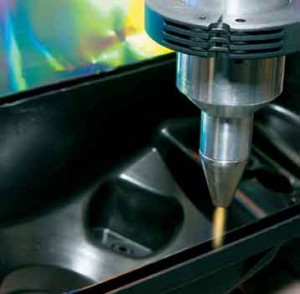Optimizing Adhesion to Automotive Plastics
Dec 17th, 2008 | By kmaier@enerconmail.com | Category: Automotive, Field ApplicationsSurface Modification Techniques for Optimizing Adhesion to Automotive Plastics examines the benefits of using surface treatment technology on low polarity plastics commonly used in the automotive industry.
INTRODUCTION
The utilization of plastics in the production of automotive parts has been steadily growing world-wide. Considering their key functional advantages, plastics have good performance characteristics, are lightweight, relatively inexpensive and are easy to manufacture. Among the various types of plastic which are used in automotive parts, thermoplastic polyolefins (TPO) have become the material of choice for exterior automotive applications such as bumpers and claddings. TPO and PP are the fastest growing due to their mechanical properties and their advantages relative to recycling.
As the use of propylene-based plastics has increased, so has the importance of coatings for these particular substrates, which are inherently non-polar. Typically, surface coatings are used on plastic substrates for decorative and protective purposes. Because coatings are based on polar polymer materials, the adhesion of polar coatings to untreated non-polar substrates like TPO are difficult. The lack of adhesion can be attributed to poor surface wetting, poor solubility of the substrate and lack of bonding between an organic coating and the substrate. In general, solubility parameters have been used to estimate polarity of a material. For instance, the solubility of polypropylene is relatively low at 7.9 (cal/cm3). Pre-treatment technologies for propylene-based polymer surfaces such as abrasion, acid etching, adhesion promotion primers and coatings, flame, corona discharge, plasma, wet chemical, and UV light treatment are among the historical options developed to combat these poor adhesion problems prior to applying surface coatings and decorations. Each of these treatments increases surface tension of the substrate by introducing polar function groups such as hydroxyl and carboxyl groups onto plastic surfaces, thereby allowing polar interfaces to better adhere. Air and flame plasma processes have been used commercially for the modification of the wetting characteristics of automotive plastic parts. While TPO, for example, has the mechanical properties needed for automotive applications, they cannot be decorated or coated without surface modification.

